Butcher Block Islands and Stools in Modern Kitchens
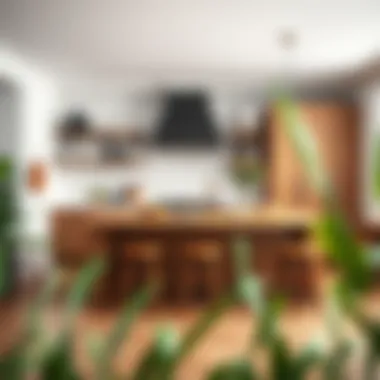
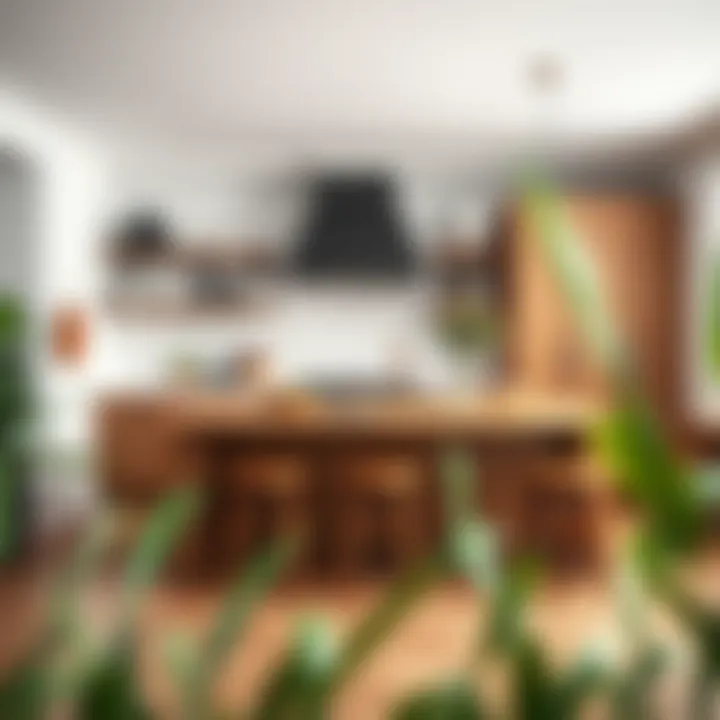
Intro
The kitchen has always been the heart of the home, a place where culinary magic happens and families gather. As we modernize our living spaces, the aesthetics and functionality of our kitchens play a pivotal role in creating a welcoming environment. Among the standout elements of contemporary kitchen design, butcher block islands represent a blend of style and utility, especially when paired with thoughtfully chosen stools. This article will delve into the nuanced relationship between butcher block islands and stools, exploring their historical significance, material choices, and design trends that resonate with today's homeowners. We'll equip you with insights that help navigate the maze of options, ensuring that your kitchen reflects both your functional needs and aesthetic desires.
Furniture Styles and Trends
Modern vs. Traditional: Understanding the Aesthetics
Butcher block islands can straddle the line between sleek modernity and rustic charm. In modern designs, you often see clean lines and minimalist aesthetics, where the islands are integrated with materials like quartz or stainless steel. The butcher block adds warmth that counters the coldness of these materials, making it not just functional but a focal point of interest.
On the flip side, traditional designs embrace the age-old craftsmanship of butcher blocks, often showcasing rich wood grains and detailed finishes. Whether crafted from hard maple, walnut, or cherry, these islands carry a sense of history and craftsmanship that can complement ornate kitchen styles.
Balancing these two styles can transform an ordinary kitchen into something extraordinary. A modern butcher block island with vintage-inspired stools can create a unique juxtaposition that stirs conversation and admiration.
Color and Material Trends: What's In and What's Out
The color palette of your butcher block island should resonate with the overall kitchen design. Currently, there’s a trend toward lighter woods or even white-washed finishes, which can brighten up the space. However, darker stains remain popular as they add depth and elegance.
Material wise, solid hardwood remains king for butcher blocks given its durability and longevity. However, an increasing appreciation for composite woods and eco-friendly options is on the rise. These materials offer modern aesthetics with the benefit of sustainability, appealing to homeowners keen on environmental responsibility.
- Current Trends:
- Outdated Trends:
- Lighter wood finishes
- Composite materials, often bamboo or recycled wood
- Eco-friendly options
- Overly dark stains that can make the space feel smaller
- Plastics or laminate that don’t offer the same charm as natural wood
Furniture Care and Maintenance
Tips for Prolonging the Life of Your Furniture
Maintaining the beauty and functionality of your butcher block island is crucial. Here are some pointers to keep it in top shape:
- Regular Cleaning: Use a mild soap solution and avoid soaking the wood to prevent warping.
- Oil Treatment: Apply mineral oil every few months to nourish the wood and keep it sealed.
- Heat Protection: Always use trivets for hot pots and pans, protecting the surface from heat damage.
DIY Repair Hacks for Common Furniture Issues
Even with the best care, furniture can show signs of wear. Here are some DIY fixes for common issues:
- Scratches: Make a paste using equal parts vinegar and olive oil. Apply it to the scratch with a soft cloth, and it can help blend the scratch back into the surface.
- Water Stains: For stubborn water rings, sanding lightly followed by re-oiling can often restore the look.
In the dance of design and practicality, butcher block islands with matching stools continue to hold their ground as timeless additions in kitchens. By understanding both current trends and maintenance needs, you can make an informed decision that will serve your home beautifully for years to come.
Historical Context of Butcher Block Islands
The historical significance of butcher block islands cannot be overstated when discussing kitchen design. These islands have evolved from mere utilitarian surfaces to becoming focal points of culinary creativity and aesthetic appeal in modern homes. By understanding their origins, design evolution, and cultural influences, one can appreciate the intricate relationship between functionality and aesthetics that these islands embody.
Origins in Culinary Practices
Butcher block surfaces trace their roots back to humble beginnings in kitchens where butchers required sturdy, durable surfaces for their work. The first butcher blocks were simply thick wooden slabs, often made from maple or oak, that served a singular purpose: to withstand the rigors of meat processing. Over time, their practicality caught the eye of homemakers and chefs alike, leading to their incorporation into home kitchens.
These surfaces began evolving, being integrated not just as cutting boards but as central gathering spots during meal preparation. In many families, the kitchen became the heart of the home, where stories were shared and lessons learned over the chopping of vegetables or the kneading of dough. As culinary practices advanced, with gourmet cooking becoming more of a hobby than a chore, the necessity for a designated area that catered to both preparation and interaction became evident.
Evolution Through Design Trends
As tastes changed, so did the design elements associated with butcher block islands. The 20th century brought about a series of design movements that influenced how these islands were structured and perceived. In the mid-century, for example, minimalist aesthetics reached the forefront, with clean lines and simplicity being favored. This led to stuff like butcher block islands being designed with lighter woods, integrated storage solutions, and a sleeker look.
Conversely, the rise of rustic design trends saw a resurgence in heavy, contoured butcher block islands made from reclaimed wood. These designs favored not just utility but also a nostalgic aesthetic that harked back to simpler times. This evolution continues as one sees modern, sleek butcher block islands harmoniously blending with the high-tech appliances of today’s kitchens.
Cultural Influences on Usage
Butcher block islands hold unique cultural significance that varies across different regions. In European kitchens, these islands often symbolize a connection to the past, serving as a vessel for traditional cooking methods and recipes passed down through generations. In contrast, the American kitchen has adopted a more casual, social interpretation where butcher block islands serve not just as functional spaces but as conversational hubs for family and friends.
Cultural attitudes towards food also shape how these islands are utilized. In some Asian cultures, the preparation of food in proximity to family members fosters a sense of community and sharing. As a result, the design of the butcher block island evolves to include features that invite participation from multiple people at once.
"A butcher block island is more than just a surface; it’s a bridge between culinary tradition and modern living."
This multifaceted historical context of butcher block islands illustrates their journey from being purely functional surfaces to integral parts of kitchen design that cater to both aesthetic preferences and sociocultural dynamics. Through these changes, they continue to adapt and inspire, remaining relevant in homes across the globe.
Material Considerations for Butcher Block Islands
The choice of material for butcher block islands plays a pivotal role in their overall performance and aesthetic appeal. When evaluating a kitchen's design, the durability, feel, and appearance of the material can either enhance or detract from the space. Not only does the right material contribute to the functionality of the island, it can also harmonize with the overall kitchen decor. With this in mind, let’s delve into the specifics surrounding the materials commonly used for butcher block islands, analyzing their suitability for various kitchen settings.
Types of Wood Used
Wood is at the heart of butcher block islands, acting as the canvas upon which both function and beauty unfold. The choice of wood can greatly affect the texture and style of the island. Common woods include hardwoods like maple, walnut, and cherry.
- Maple is known for its fine grain, making it a popular choice for durability and easy maintenance. It can take heavy chopping and slicing without showing much wear.
- Walnut brings a rich, warm tone that can create a stunning focal point in a kitchen. Its natural color variations offer unique visual appeal.
- Cherry ages beautifully over time, darkening to a deep reddish hue that adds character to the island.
Each type of wood has its characteristics, allowing homeowners and designers to pick based on their desired look and functional needs.
Durability and Longevity
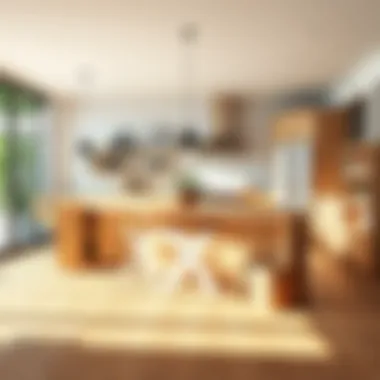
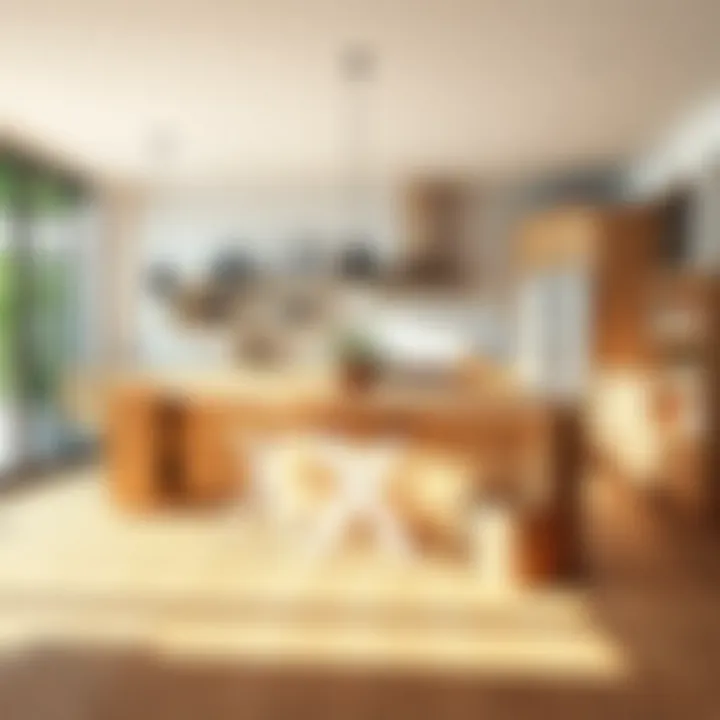
Durability is a significant consideration when selecting wood for butcher block surfaces. Chefs and home cooks alike depend on durable materials that can withstand repeated use.
- Butcher block islands are often subjected to heavy wear and tear, from cutting and slicing to leaning against them while cooking.
- A well-maintained butcher block surface can last for decades, provided the right steps are taken to care for it.
- Regularly treating the wood with mineral oil can enhance its life span, preventing cracks and drying.
Choosing a durable wood ensures that the island maintains its structural integrity and visual appeal throughout the years, making it a worthwhile investment.
Sustainability in Material Choices
In today’s world, sustainability often sits atop the priority list for homeowners. When considering butcher block islands, selecting sustainable wood sources can have a positive environmental impact.
- Reclaimed Woods are one excellent option. Utilizing wood that has been salvaged not only reduces waste but also adds a unique story to the kitchen space.
- Look for certifications like the Forest Stewardship Council (FSC) that guarantee responsible, sustainable harvesting of materials.
- For those conscious of their ecological footprint, options like bamboo, though technically a grass, can be a more sustainable choice, as bamboo grows quickly and is a renewable resource.
As consumers become increasingly aware of their choices, opting for sustainable materials sets a positive example and supports eco-friendly practices.
Proper material selection goes beyond aesthetics; it’s a vital component in ensuring that butcher block islands meet both functional demands and environmental standards.
Designing the Butcher Block Island
When it comes to designing a butcher block island, it isn't just about picking out a slab of wood and calling it a day. This central feature of the kitchen plays a pivotal role in not only the practicalities of food preparation but also how the space feels and flows. The importance of this topic lies in effectively marrying form with function. Choosing the right size, ensuring seamless integration with your kitchen layout, and selecting appropriate styles and finishes can elevate a kitchen from merely functional to downright inviting.
Selecting the Right Size
Tackling the question of size is like navigating a minefield; get it wrong, and your kitchen could end up feeling cramped or chaotic. But how do you decide what size is appropriate? Here are a few pointers:
- Space Availability: Measure your kitchen and use this as a guideline. Ideally, there should be at least 36 inches of clearance around the island for comfortable movement.
- User Needs: Consider how you’ll use the island. If it’s primarily for prep, a larger surface might be in order. However, a more modest size could suffice if it's just for occasional extra cooking space.
- Stool Space: Don’t forget to account for the stools; they need room to slide in and out freely. Generally, aim for about 24 inches of width per stool to keep things comfy.
Integration with Kitchen Layout
Crafting a butcher block island that meshes seamlessly with your kitchen layout is crucial. You're not building a standalone piece of furniture; this is meant to be a part of a larger ecosystem. Here are some things to consider when integrating this island:
- Traffic Flow: Visualize how people will move through the kitchen. The island shouldn’t obstruct pathways to the fridge, stove, or sink. Ideally, the layout should facilitate a triangle pattern among these areas for optimal flow.
- Function Zones: Think about establishing distinct zones on the island. One side could be dedicated to prep work, while the opposite offers seating. Creating these zones helps in reducing chaos during meal prep times.
- Utilities: Don't forget about the potential for additional functionality, like incorporating electrical outlets or small appliances, enhancing the usefulness of the space without overwhelming it.
Aesthetic Styles and Finishes
All the functionality in the world can’t compensate for a butcher block island that looks out of place. The aesthetic appeal is equally important, and it can vary widely based on personal taste and overall kitchen design:
- Traditional: Rich, dark woods with a polished finish offer a classic look that pairs wonderfully with vintage or farmhouse kitchens.
- Modern: Light-colored woods with a matte finish can lend a sleek, contemporary feel, perfect for a minimalist kitchen.
- Mixed Materials: Combining butcher block with other surfaces, such as a metallic frame or a quartz countertop, can create a unique focal point that catches the eye.
"Your kitchen island should not only serve a purpose but also tell a story about who you are and how you live."
Once you’ve established the size and layout, consider how the colors and textures of the island connect with other elements in the kitchen. A cohesive look resonates more strongly than a haphazardly assembled collection of features.
In summary, designing a butcher block island is not merely a checklist of tasks, but a carefully orchestrated process that marries utility with style. From selecting the appropriate size that complements your kitchen’s flow, integrating it seamlessly with the layout, and choosing finishes that reflect your personal taste, each step builds toward creating a cohesive and functional heart to your kitchen.
Choosing Stools for Your Butcher Block Island
Selecting the right stools to accompany your butcher block island plays a crucial role in merging functionality with aesthetic appeal. This isn't just about finding a place to sit; it's about crafting an inviting atmosphere where meals are prepared, conversations flow, and memories are made. The ideal stools should complement the island's design while meeting specific functional needs. Here, we explore vital aspects including height compatibility, materials used, and how to ensure a cohesive look that ties the kitchen together.
Height Compatibility
One of the first considerations must be height, as an uncomfortable mismatch can lead to frustrations during meal times or casual lounging. Standard butcher block islands typically align between 36 to 42 inches high, which sets the stage for choosing stools ranging from 24 to 30 inches in seat height. Just imagine trying to balance yourself on a stool that feels too high or, worse yet, having to hunch down awkwardly on a stool that's too low.
To determine the proper height, measure your island's height and subtract about 10 to 12 inches for optimal legroom. A quick tip: if you have a mixed group of family members or guests, bar stools may offer a more versatile approach, particularly if they are adjustable in height. Beyond that, it’s wise to factor in the thickness of your butcher block surface when making these calculations.
Materials and Durability
Next up is durability. With hefty chopping and everyday culinary escapades, your stools need to keep pace. Common materials include solid wood, which brings warmth and natural beauty to the kitchen, but it's important to consider varnished or treated finishes that withstand spills and scratches. Metal stools with padded seats are another solid option, providing robustness that’s often easier to clean.
In the realm of faux leather or fabric, one must acknowledge that while they may offer comfort, these materials can pose challenges when it comes to stains or wear. It’s like buying a flashy car – looks great until you realize it’s a gas guzzler! One resourceful choice is to look for stools designed for outdoor use, as their materials are typically more resilient and spill-resistant.
Design Synergy with the Island
Design synergy refers to how well the stools carry over the aesthetic of the butcher block island into the rest of the kitchen. It is essential that they harmonize without losing individual character. For a rustic kitchen setting, a reclaimed wood stool could connect beautifully with the old-world charm of a natural wood butcher block. Conversely, sleek metal or minimalist designs align well with contemporary islands laden with intricate details.
Color also plays a massive role here. A wooden island could be complemented with pastel or vibrant-colored stools for added pop, while monochromatic palettes promote a more subdued and sophisticated look. Remember, the goal is not just to fill seats, but also to create a conversation starter.
"The essence of a good stool is that it must invite people to enjoy the experience beyond just a meal, but to engage with the heart of the kitchen itself."
Ultimately, choosing stools for your butcher block island is a journey of balancing practicality and aesthetics. Taking the time to consider these aspects will lead you to a selection that boosts the overall vibe of your kitchen while providing a perfect perch for meals and gatherings.
Functional Aspects of Butcher Block Islands
Butcher block islands serve more than just a beautiful centerpiece in the kitchen; they play a pivotal role in everyday cooking and socializing. Here, we will break down the various functional aspects that make these islands invaluable, providing homeowners and designers a deeper insight into their utility.
Prep and Cooking Space
When it comes to food preparation, having ample space is crucial. Butcher block islands are often constructed with sturdy wood surfaces that stand up well against knives and other kitchen tools. This is not only about aesthetics but also practicality. A well-sized butcher block island can turn a cramped kitchen into a baker's paradise or a chef's dream, allowing for seamless chopping and dicing.
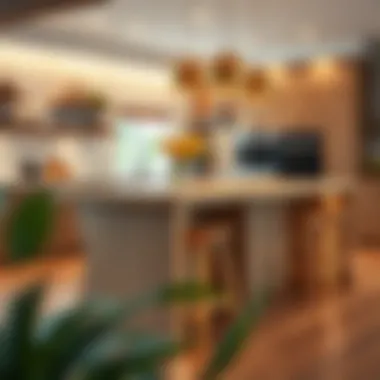
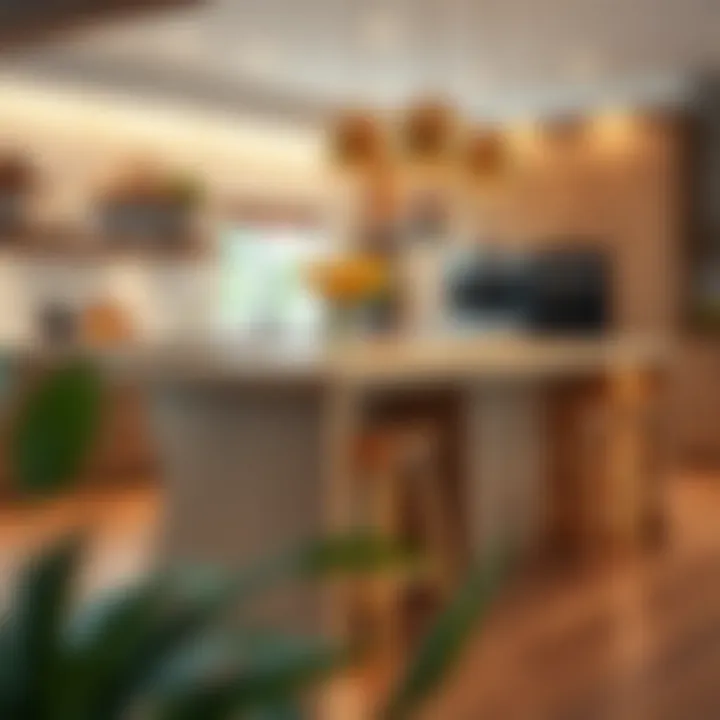
One of the fantastic elements of these islands is that they can act as a designated area for meal prep, separating it from the dining area. This delineation can help keep the kitchen less cluttered during cooking while allowing smoother transitions between different stages of meal preparation. In addition, the wood's natural resistance to bacteria makes it a preferred choice as a cutting surface.
Here's how you can maximize your butcher block island for prep work:
- Ensure Adequate Surface Area: The larger the island, the more space you have for working.
- Integrate Built-in Appliances: Incorporating elements like stove tops or built-in mixers can save significant space and streamline the cooking process.
- Maintain a Clean Surface: Regular cleaning and care will keep the wood in top condition, ensuring it stays a reliable prep area for years on end.
Social Interaction Area
Butcher block islands create a welcoming atmosphere. The convenience of having a place where family and friends can gather transforms an otherwise solitary task, such as cooking, into a social event. An island can become a hub for conversation, where people can hang out while the chef whips up a meal. By positioning stools around the island, it’s easy for guests to pull up a seat and catch up while snacks are prepared.
A few design choices can emphasize this interactive function:
- Choose Comfortable Seating: Opt for stools that are not only stylish but comfortable enough for prolonged conversations.
- Consider Open Concepts: It’s often ideal to have the island face toward common areas to foster a better connection among those in the kitchen and those in the adjoining rooms.
- Use Warm Lighting: Good lighting can set the tone for a friendly atmosphere, helping to invite people into the kitchen.
"A kitchen isn’t just about cooking; it’s about community and making connections, and a butcher block island facilitates that.”
Storage Solutions
Another important aspect of butcher block islands lies in their ability to provide practical storage solutions. Whether your kitchen is petite or spacious, effective storage strategies can make all the difference. Islands can be designed with built-in cabinets or drawers, offering easy access to kitchen essentials without cluttering countertops.
- Incorporate Shelving: Open shelving underneath can house cookbooks, pots, or decorative items, providing both accessibility and style.
- Use Drawers Wisely: Consider drawers that incorporate dividers or pull-out trays to maximize storage efficiency.
- Under-counter Refrigerator Options: This allows for the rapid access of food and drinks while the area remains neat and tidy.
With these functional aspects, butcher block islands are not only a stylish addition to your kitchen but also a cornerstone for practical cooking and social activities. They meld the needs of everyday life with the aesthetics of modern design, serving as a testament to the harmony of functionality and style.
Styling and Decor Ideas
When it comes to creating a kitchen that speaks to both functionality and elegance, styling and decor ideas play a pivotal role. A butcher block island not only serves as a practical workspace but also shapes the overall aesthetic of the kitchen. By focusing on specific elements such as color schemes, patterns, accessories, and lighting, homeowners and designers can craft spaces that feel cohesive and inviting.
Color Schemes and Patterns
Selecting a color scheme can set the tone for your kitchen. Consider how the warm hues of the butcher block contrast with cooler wall colors. Imagine a rich chestnut table paired with soft pastel walls or vibrant tiles that accentuate a natural wood finish.
- Warm Tones: Warm colors like terracotta or sunflower can complement the natural wood, adding a homely touch.
- Cool Shades: Conversely, cooler shades like slate blue or soft green can create an elegant backdrop that highlights the beauty of the butcher block.
- Patterns: Think about incorporating patterns through fabric choices or decorative accents—aprons, cushions, or chair covers that incorporate geometric or floral designs can bring life to the space.
It’s important to ensure that the chosen colors and patterns not only resonate with the butcher block finish but also blend with the entire kitchen decor. This cohesive approach without causing sensory overload can promote a serene cooking environment, allowing for culinary creativity.
Incorporating Accessories
Accessories can transform a simple butcher block island into a statement piece. Strategizing which elements to introduce can enhance both the aesthetic appeal and functional usability.
- Functional Accessories: Items like cutting boards, knife holders, or rustic fruit bowls are not just for utility but can also serve decorative purposes. An antique knife block resting atop the island can add charm while remaining practical.
- Seasonal Decor: Use decor that changes with the seasons—think autumnal pumpkins in a wooden crate or fresh herbs in stylish pots during summer. This brings dynamism to your kitchen’s look.
- Textiles: Dishtowels, table runners, or even decorative bowls can add texture and color. Choose fabrics that resonate with your overall color palette and style.
By carefully selecting accessories that speak to the essence of your kitchen, you turn your butcher block island into a central figure of culinary and stylistic significance.
Lighting Considerations
Lighting is crucial in enhancing the visual appeal and functionality of a butcher block island. It helps create an inviting atmosphere and ensures that workspaces are well-lit. Here are some ideas to consider:
- Ambient Lighting: Use soft, warm lighting to create a cozy atmosphere. This can be achieved through recessed lighting or sconces that don’t overpower the space.
- Task Lighting: Focused lighting, such as pendant lights hanging directly above the island, ensures that cooking tasks are performed safely and effectively. Choosing fixtures that complement the style of the butcher block, like industrial metals or rustic woods, adds a layer of connection to the overall design.
- Accent Lighting: Consider accent lighting that highlights other decor elements. Spots on artwork or under-cabinet lights can elevate the visual dynamics during the evening hours.
"The correct lighting can turn a traditional butcher block island into a piece of art, making it the heart of the kitchen for any culinary enthusiast."
By addressing these essential elements, the styling and decor of a butcher block island become an expression of personal taste and a fusion of aesthetics with functionality. Through careful color selections, thoughtful accessorization, and appropriate lighting, you can create a kitchen that is not just a place where meals are prepared, but a vibrant, stylish realm where memories are made.
Maintenance of Butcher Block Islands
Maintaining a butcher block island is akin to taking care of a finely tuned instrument. The longevity and performance of such a centerpiece in your kitchen rely heavily on consistent care and attention. Not only does routine maintenance enhance the appearance, but it also ensures optimal functionality. A well-kept butcher block island can serve you tirelessly, offering both a reliable work surface for food prep and an inviting spot for social gatherings. Understanding the nuances of maintenance is essential for homeowners and design enthusiasts alike.
Cleaning and Care Tips
Keeping your butcher block clean isn’t just about appearance; it's also about hygiene. After all, this surface often hosts various ingredients, from fresh vegetables to raw meats. Here are some practical tips to maintain its cleanliness:
- Daily Wipe-Down: Use warm, soapy water and a soft sponge to wipe down after each use. Avoid soaking the wood.
- Natural Cleaners: For tougher stains, a mixture of baking soda and water can be employed. Scrub gently with a non-abrasive pad.
- Avoid Harsh Chemicals: Steer clear of bleach or ammonia-based cleaners as they can harm the finish and texture of the wood.
- Dry Immediately: After cleaning, pat the surface dry to prevent moisture from seeping into the wood, which can lead to warping or cracking.
Engaging in these routine practices not only boosts the aesthetic appeal but also prolongs the lifespan of your butcher block island, making it a steadfast companion in your culinary adventures.
Repairing Damage
Even the most robust butcher block islands can face the occasional mishap. Whether it’s scratches from kitchen tools or dents caused by careless handling, addressing these issues promptly is essential. Here’s how you can tackle some common forms of damage:
- Surface Scratches: Begin by lightly sanding the affected area with fine-grit sandpaper. Be sure to follow the wood grain, drying it with a soft cloth afterward.
- Deep Gouges: For deeper wounds, you may need to apply wood filler that matches the color of your block. After it's dry, sand it flush to the surface.
- Dents: Use a damp cloth over the dent and apply heat with an iron for a few seconds. This may expand the wood fibers, helping them rise back into place.
Repairing your butcher block promptly ensures it remains functional while preserving the beauty of your kitchen.
Seasoning the Surface
Just as a cast-iron skillet benefits from seasoning, so does a butcher block island require periodic oiling to keep it in prime condition. Seasoning the wood not only enhances its visual appeal but also adds a protective layer that defends against moisture, bacteria, and stains. Here’s a guide to properly season your butcher block:


- Choose the Right Oil: Opt for mineral oil or a specialized butcher block oil. These options are food-safe and do not go rancid like other culinary oils.
- Application Frequency: Aim to oil the surface once a month, or more if the wood appears dry.
- How to Apply: Pour a liberal amount of oil onto the surface, using a cloth to spread it evenly. Allow the oil to soak for at least a few hours or overnight for thorough absorption.
Oiling not only aids in moisture retention but also enhances the natural hue of the wood, creating a rich luster that catches the eye.
The care and maintenance of your butcher block island involve straightforward practices that yield significant benefits. With adequate cleaning, repairing small damages, and regular seasoning, your butcher block can continue to enhance both the functionality and the aesthetics of your kitchen for years to come.
Challenges in Choosing a Butcher Block Island
When it comes to selecting a butcher block island, challenges can be as plenty as the grains in the wood. Choosing the right island is not just about aesthetics; it encapsulates functionality, space management, and even lifestyle adaptations. While these islands are known for their rustic charm and practicality, navigating common challenges can ultimately help in creating a cohesive kitchen design. Understanding these hurdles leads you to a choice that's not only pleasing to the eye but functional too.
Space Limitations
In urban settings or smaller homes, space limitations can serve as a major stumbling block for homeowners. Measuring available area becomes essential. If you decide on a butcher block island that is too big, it might block essential pathways, making the kitchen feel cramped. On the flip side, an undersized island may fail to deliver its purpose, providing insufficient prep space and seating. A good rule of thumb is to ensure that there’s at least three feet of walkable space around the island.
"Space is like fashion: too much room can look empty, but too little can become suffocating."
Consider opting for a customized design to fit every nook and cranny of your kitchen. Here are a few tips for maximizing space:
- Incorporate vertical storage: Use shelves above the island for utensils and cookbooks.
- Select a multi-functional island: An island with built-in shelving or pull-out drawers can save room.
- Choose stools that tuck underneath: Compact stools ensure unencumbered pathways.
Cost Considerations
Financing a new butcher block island can lead to unforeseen calculations that put a wrench in your plans. The cost often extends beyond the initial price tag of the island itself. Factors like installation fees, shipping costs, and additional materials and tools can add up quicker than you think. More than just price, consider investment viability and how the new addition will enhance the value of your property.
When budgeting for your butcher block island, take into account:
- Type of wood: Hardwoods like maple or walnut can be pricier but offer longevity.
- Finish options: Oil vs. varnish can alter not just price but maintenance routine.
- Installation costs: DIY might save money, but consider hiring a professional for a polished look.
By appropriately weighing these considerations, homeowners can make a more informed financial decision that contributes to their kitchen’s longevity and appeal.
Lifestyle Compatibility
Understanding your lifestyle is crucial in selecting the right butcher block island. Is it just for show, or do you plan on whipping up gourmet meals every night? If you have a penchant for cooking, a larger, more robust island may be essential. In contrast, if your use is primarily aesthetic or occasional, a smaller, stylish piece may suffice.
Here are elements to consider for enhancing lifestyle compatibility:
- Cooking habits: Frequent cooks will appreciate spacious prep areas and high-quality surfaces.
- Social gatherings: Families with kids and guests may require more seating.
- Daily routine: For those who like quick meals on the go, a minimalistic style might fit better.
Putting thought into how you will interact with your butcher block island ensures that what you choose will align with your daily activities and not just your decor goals.
Emerging Trends in Kitchen Islands
The kitchen is no longer just a space for meal prep; it's become a gathering spot, a social hub, and a canvas for creative home design. In today’s world, where innovation meets aesthetics, emerging trends in kitchen islands play a crucial role. Kitchen islands now serve multiple purposes, reflecting not only functionality but also the personality of the home. This section will dive into the exciting developments defining modern butcher block islands and the accompanying stools.
Smart Technology Integration
Smart technology is transforming how we interact with our kitchens. Today’s butcher block islands can be complemented by smart gadgets—from built-in wine coolers to integrated charging ports for your devices. Imagine having a state-of-the-art induction cooktop embedded in your island or lighting that adjusts based on the time of day.
Adding smart features not only boosts efficiency but also enhances user experience. For example, some islands now come with touch-screen controls embedded into the butcher block surface, allowing you to access recipes, set timers, and even adjust ambient lighting at a tap. It’s a blending of technology and design, ensuring that kitchens are both modern and practical.
"Incorporating smart technology into kitchen islands revolutionizes user interaction and enhances the overall cooking experience."
Sustainable Design Practices
Sustainability is more than just a buzzword—it's crucial for our environment and our future. Incorporating sustainable practices into kitchen design has become a necessity for many homeowners. Butcher block islands made from reclaimed wood or sustainably sourced materials not only minimize environmental impact but often tell a story of their previous life.
With the rise of eco-friendly finishes, such as natural oils and waxes, maintaining these surfaces has become as straightforward as the principles behind sustainable production. These finishes protect the wood while ensuring a lower level of harmful chemicals in your home. Additionally, opting for islands built with bamboo or other rapidly renewable resources can drastically reduce your carbon footprint and promote a more sustainable lifestyle.
Versatile Multi-Functional Islands
Gone are the days when kitchen islands simply served as a place to chop vegetables or eat breakfast. Today's design trends focus on multi-functional islands that cater to diverse needs. They can serve as dining tables, workspaces, or even small appliances’ docking stations. This versatility is especially significant in smaller kitchens where maximizing space is essential.
Consider islands that feature built-in storage solutions or those that include pull-out serving trays. Some designs incorporate the cooking area on one side, with seating on the other, creating a seamless transition from meal prep to meal enjoyment. With the right design, a butcher block island can evolve from a kitchen centerpiece to an essential hub of daily life, accommodating everything from family dinners to casual brunches.
By embracing these emerging trends, homeowners can create sophisticated and innovative kitchen islands that align with their lifestyle and enhance the overall kitchen experience. Whether it's through smart technology, sustainable practices, or multipurpose designs, the future of kitchen islands seems not just functional but also exciting.
Ending and Future Perspectives
As we draw our discussion to a close, it's essential to reflect on the intricate relationship between functionality and aesthetics within the context of butcher block islands and stools in modern kitchens. This combination is not merely about choosing a nice design or a convenient place to chop vegetables; it encompasses their role in fostering interactions, enhancing utility, and even making a lasting impression in our homes.
Reflecting on Functionality and Aesthetics
Butcher block islands serve as the heart of the kitchen—where culinary magic unfolds, family bonds strengthen, and memories are etched into the wood grain. The functionality of these islands lies in their versatile nature, allowing for prep work, casual dining, or simply a spot to gather. However, aesthetic appeal cannot be brushed aside. A well-designed butcher block can elevate the entire kitchen environment. The right choice of wood, finish, and design can seamlessly integrate with the overall theme of your home, making it both practical and visually stunning. It’s all about finding that sweet spot where utility meets beauty.
Encouraging a Thoughtful Approach to Design
When it comes to designing kitchen spaces, homeowners and designers alike must take a thoughtful approach. This transcends mere trends; it involves understanding the specific needs of your household. Consideration for how a butcher block island will fit into daily life is paramount. For example, is it primarily used for meal preparation, or is it more of a gathering place for friends and family? Answering these questions paves the way for choices that truly reflect your lifestyle. Additionally, integrating materials that stand the test of time, both in durability and style, will echo your commitment to quality.
Creating Timeless Spaces
Finally, creating timeless spaces with butcher block islands calls for an understanding that kitchen design is an investment. Selecting materials and designs that won’t fall out of fashion within a few years is crucial. Wood finishes and simple lines often age gracefully, adding character over time and making your kitchen a place that's not only functional but also steeped in history and rich story. Incorporating classic elements can harmonize with contemporary touches, giving you the best of both worlds.
In wrapping up this exploration, it’s clear that butcher block islands and stools are more than mere furniture; they are vital components of a well-crafted kitchen space. By focusing on thoughtful design and the balance of aesthetics with functionality, we prepare ourselves for future trends while also crafting timeless spaces that continue to inspire.















